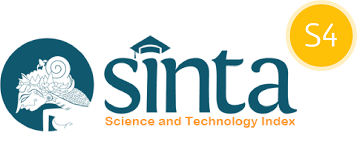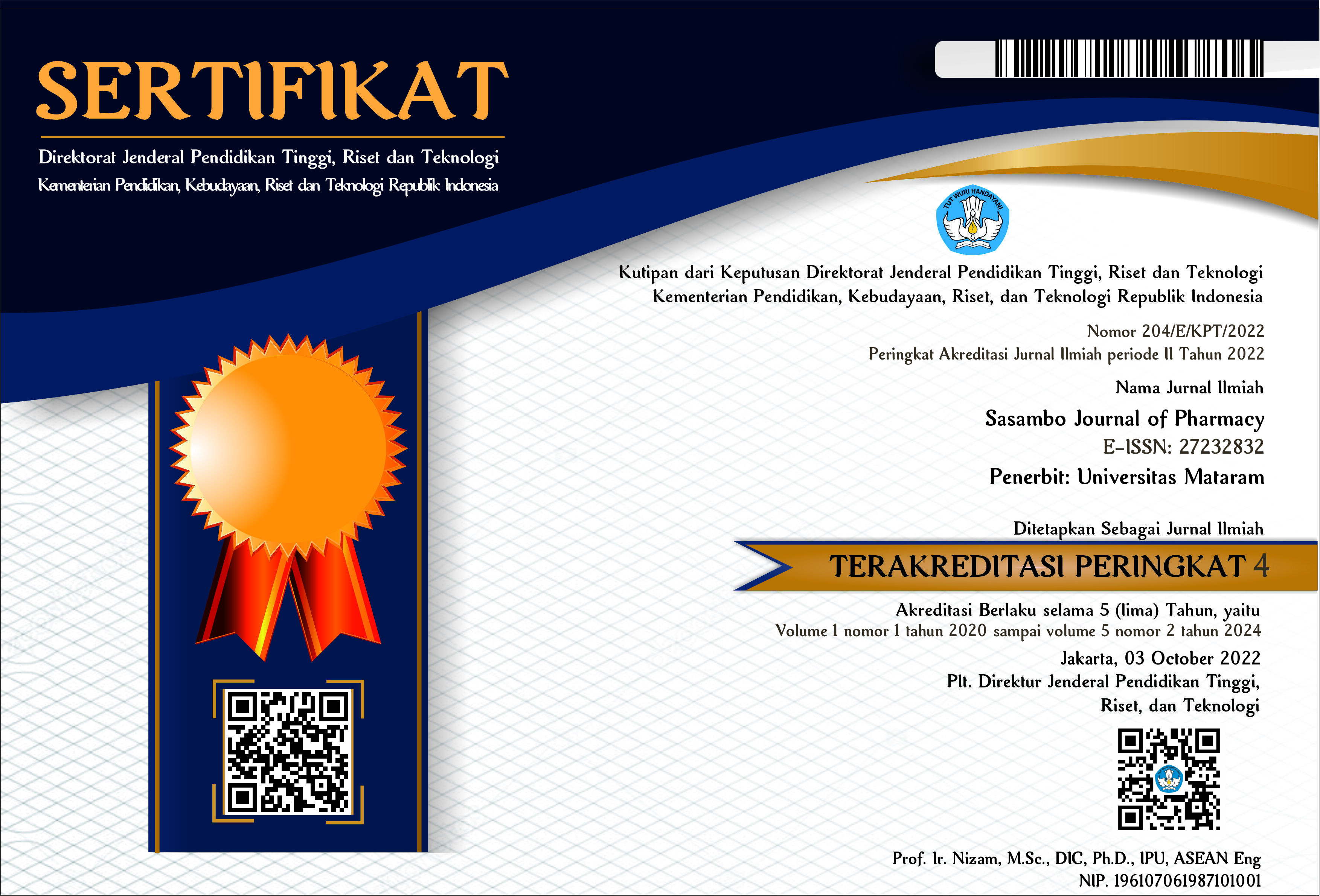Pola peresepan antibiotik pada pasien infeksi saluran kemih di instalasi rawat jalan RSUD Provinsi NTB tahun 2017
DOI:
10.29303/sjp.v2i1.26Downloads
Abstract
Urinary tract infection (UTI) is an infection due to the proliferation of microorganisms in the urinary tract. UTI is usually occur in the community at various ages. In 2014, Indonesian Ministry of Health showed that the number of people with UTIs reached 90-100 cases per 100,000 population per year. Antibiotics are the main therapy used in treating urinary tract infections. The purpose of this study was to determine the pattern of antibiotic prescribing in UTI patients and determine the suitability of therapy with guidelines for UTI at the Installation of NTB Provincial Hospital in 2017. The design of this study was descriptive by collecting data retrospectively. The study was conducted on 105 UTI patients at the Installation Hospital of NTB Province in 2017, then the data obtained from the medical record and prescription sections were processed using Microsoft Excel software. The results showed that therapy for UTI patients was antibiotics with the most use of ciprofloxacin (45.71%), then cefixime (40%), urinter (pipemidic acid) (11.43%), levofloxacin (1.90%), cefadroxil (0.95 %). Based on these results, the suitability of prescription was seen from the type of drug and the dosage in the main therapy (antibiotics) was 100% according to the treatment guidelines, but the frequency and duration of administration only reached 99.05% and 88.6%.
Keywords:
Urinary tract infections, Antibiotics, Prescription patternsReferences
S., 2008., Pattern of prescribing practices in the Madhya Pradesh, India. Kathmandu University Medical Journal, 6(1), 55–59.
Coyle, E.A., and Prince, R.A. (2005). Urinary Tract Infection, in Dipiro J.T., et al. Pharmacotherapy A Pathophysiologic Approach. 6th edition. Stamford: Appleton & Lange.
Depkes RI. (2010). Peraturan Mentri Kesehatan Republik Inndonesia Nomor HK.02.02/MENKES/068/I/2010, tentang Kewajiban Menggunkan Obat Generik di Fasilitas Pelayanan Kesehatan. Jakarta: Departemen Kesehatan RI.
Febrianto, Aldy Wijaya., Alwiyah Mukaddas., dan Inggrid Faustine. (2013). Rasionalitas Penggunaan Antibiotik pada Pasien Infeksi Saluran Kemih (ISK) di Instalasi Rawat Inap RSUD Undata Palu Tahun 2012. Online Jurnal of Natural Science Vol.2(3): 20-29
Indijah, S.W. (2016). Modul Bahan Ajar Cetak Farmasi : Farmakologi. Jakarta: Kementerian Kesehatan Republik Indonesia, hal. 38.
Jenny, Pantoan., Okpri. M., dan Amalita, F. (2017). Pola Peresepan Antibiotik Pada Pasien Infeksi Saluran Kemih Di RSPAD Gatot Soebroto Jakarta. Social Clinical Pharmacy Indonesia Journal. Vol. 2, No. 1, p. 75.
Katzung, B. G. (2004). Farmakologi; Dasar dan Klinik. Jakarta: Salemba Medika.
Katzung, B. G., dan Anthony, J. T. (2014). Basic and Clinical Pharmacology, Thirteent Edition. San Francisco: McGraw Hill Professional, hal. 262.
Kim, B., Lim, JH., Lee, SA.. (2012). The Relation Between and Postvoid Residual and Occurence of Urinary Tract Infection after Stroke in Rehabilitation Unit. Annals of Rehabilitation Medicines; 36(2):248-53.
Mamonto, N. D., Standy, S., Heriyannis, H. (2015). Identifkasi Bakteri Aerob Pada Urin Porsi Tengah Pasien Penyakit Ginjal Kronik Stadium 5 Di BLU RSUP Prof. R.D. Kandou Manado. Jurnal e-Biomedik (eBm), Volume 3, Nomor 1.
Okonko, I. O., Ijandipe, L. A., Ilusanya, O. A. (2009). Incidence Of Urinary Tract Infection (UTI) Amongpregnant Women in Ibadan, South-Western Nigeria. African Journal of Biotechnology, 8(23), pp. 6649-6667.
Potoski, B.A. (2008). Urinary Tract Infection. In: Chisholm-Burns, M.A., Wells, B.G., Schwinghammer, T.L., Malone, P.M., Kolesar, J.M., Rotschafer, j.C., dan Dipiro, J.T., Pharmacotherapy Principles and Practice. New York: McGraw-Hill, P. 1151.
Purnomo, B.B. (2009). Dasar-Dasar Urologi Edisi Kedua. Jakarta: Sagung Seto.
Purnomo, B.B. (2010). Dasar-Dasar Urologi Edisi Ketiga. Jakarta: Sagung Seto, hal. 51 – 55, 123.
Schwartz, Seymour. I. (2000). Intisari Prinsip – Prinsip Ilmu Bedah edisi ke-6 Alih Bahasa dr. laniyati. Jakarta : EGC, hal. (60).
Sotelo, T. And Westney, L. (2003). Recurent Urinary Tract Infection in Women. Curr Women’s Health.
Thai, T., dan Zito, PM. (2018). Ciprofloxacin. Diakses dari https://www.ncbi.nlm.nih.gov/books/NBK535454/, pada tanggal 22 juli 2019.
Tjay, T. H., dan Rahardja, K., 2007. Obat-Obat Penting : Khasiat, Penggunaan, dan Efek-Efek Sampingnya. Edisi ke VI. Jakarta: PT Elex Media Komputindo, hal.193.
Utami, E.R. (2011). Antibiotika, Resistensi dan Rasionalitas Terapi. El-hayah Vol.1, No.4 dalam Munaf, S., Chaidir, J. 1994. Obat Antimikroba. Jakarta: EGC.
Zanetti, G., Paparella, S., Trinchieri, A., Prezioso, D., Rocco, F., dan Naber, K. G. (2008). Infection and Urolithiasis: Current Clinical Evidence in Prophilaxis and Antibiotic Therapy. Ach Ital Urol Androl, 80(1), 5-12.
License
Authors who publish with Sasambo Journal of Pharmacy (SJP), agree to the following terms:
- Authors retain copyright and grant the journal right of first publication with the work simultaneously licensed under a Lisensi Creative Commons Atribusi 4.0 Internasional. This license allows authors to use all articles, data sets, graphics and appendices in data mining applications, search engines, web sites, blogs, and other platforms by providing an appropriate reference. The journal allows the author(s) to hold the copyright without restrictions and will retain publishing rights without restrictions.
- Authors are able to enter into separate, additional contractual arrangements for the non-exclusive distribution of the journal's published version of the work (e.g., post it to an institutional repository or publish it in a book), with an acknowledgment of its initial publication in Sasambo Journal of Pharmacy
- Authors are permitted and encouraged to post their work online (e.g., in institutional repositories or on their website) prior to and during the submission process, as it can lead to productive exchanges, as well as earlier and greater citation of published work (See The Effect of Open Access).







